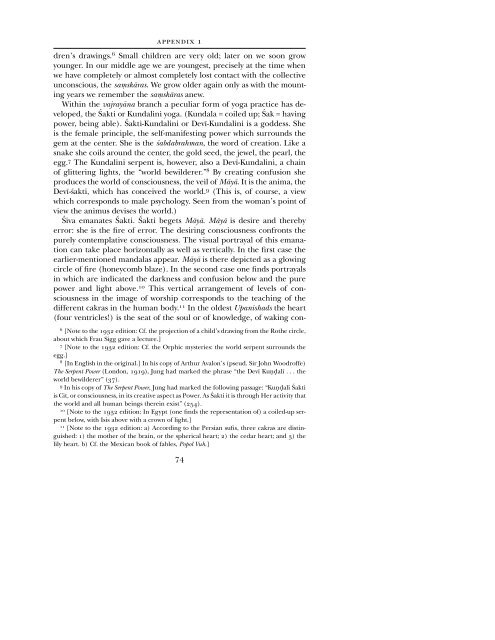CG JUNG - Countryside Anarchist
CG JUNG - Countryside Anarchist
CG JUNG - Countryside Anarchist
Create successful ePaper yourself
Turn your PDF publications into a flip-book with our unique Google optimized e-Paper software.
APPENDIX 1<br />
dren’s drawings. 6 Small children are very old; later on we soon grow<br />
younger. In our middle age we are youngest, precisely at the time when<br />
we have completely or almost completely lost contact with the collective<br />
unconscious, the saôskvras. We grow older again only as with the mounting<br />
years we remember the saôskvras anew.<br />
Within the vajrayvna branch a peculiar form of yoga practice has developed,<br />
the åakti or Kundalini yoga. (Kundala = coiled up; åak = having<br />
power, being able). åakti-Kundalini or Devz-Kundalini is a goddess. She<br />
is the female principle, the self-manifesting power which surrounds the<br />
gem at the center. She is the çabdabrahman, the word of creation. Like a<br />
snake she coils around the center, the gold seed, the jewel, the pearl, the<br />
egg. 7 The Kundalini serpent is, however, also a Devz-Kundalini, a chain<br />
of glittering lights, the “world bewilderer.” 8 By creating confusion she<br />
produces the world of consciousness, the veil of Mvyv. It is the anima, the<br />
Devz-çakti, which has conceived the world. 9 (This is, of course, a view<br />
which corresponds to male psychology. Seen from the woman’s point of<br />
view the animus devises the world.)<br />
åiva emanates åakti. åakti begets Mvyv. Mvyv is desire and thereby<br />
error: she is the fire of error. The desiring consciousness confronts the<br />
purely contemplative consciousness. The visual portrayal of this emanation<br />
can take place horizontally as well as vertically. In the first case the<br />
earlier-mentioned mandalas appear. Mvyv is there depicted as a glowing<br />
circle of fire (honeycomb blaze). In the second case one finds portrayals<br />
in which are indicated the darkness and confusion below and the pure<br />
power and light above. 10 This vertical arrangement of levels of consciousness<br />
in the image of worship corresponds to the teaching of the<br />
different cakras in the human body. 11 In the oldest Upanishads the heart<br />
(four ventricles!) is the seat of the soul or of knowledge, of waking con-<br />
6 [Note to the 1932 edition: Cf. the projection of a child’s drawing from the Rothe circle,<br />
about which Frau Sigg gave a lecture.]<br />
7 [Note to the 1932 edition: Cf. the Orphic mysteries: the world serpent surrounds the<br />
egg.]<br />
8 [In English in the original.] In his copy of Arthur Avalon’s (pseud. Sir John Woodroffe)<br />
The Serpent Power (London, 1919), Jung had marked the phrase “the Devz Kuõìalz ...the<br />
world bewilderer” (37).<br />
9 In his copy of The Serpent Power, Jung had marked the following passage: “Kuõìalzåakti<br />
is Cit, or consciousness, in its creative aspect as Power. As åakti it is through Her activity that<br />
the world and all human beings therein exist” (254).<br />
10 [Note to the 1932 edition: In Egypt (one finds the representation of) a coiled-up serpent<br />
below, with Isis above with a crown of light.]<br />
11 [Note to the 1932 edition: a) According to the Persian sufis, three cakras are distinguished:<br />
1) the mother of the brain, or the spherical heart; 2) the cedar heart; and 3) the<br />
lily heart. b) Cf. the Mexican book of fables, Popol Vuh.]<br />
74


